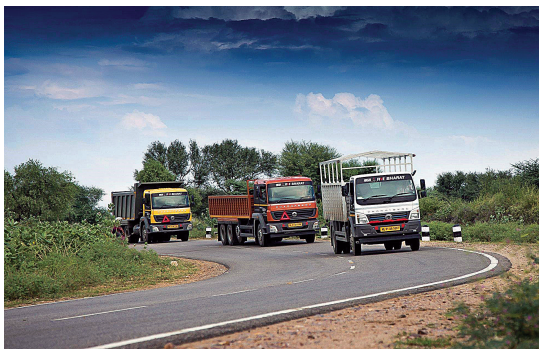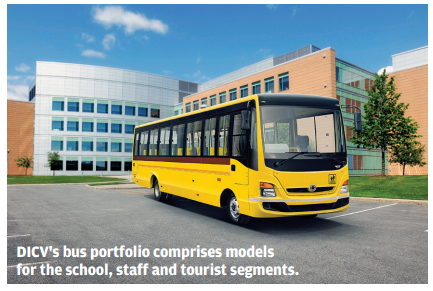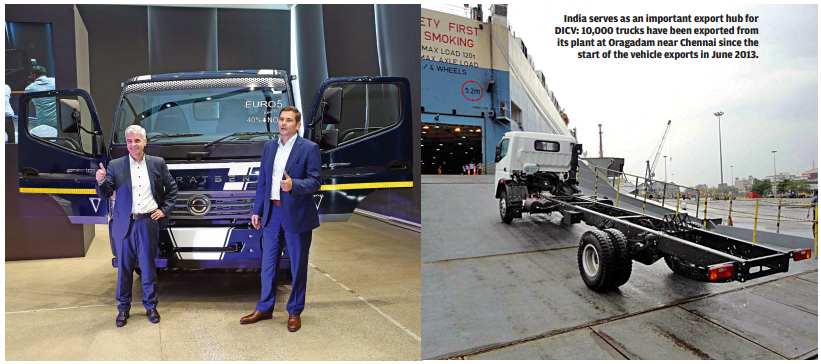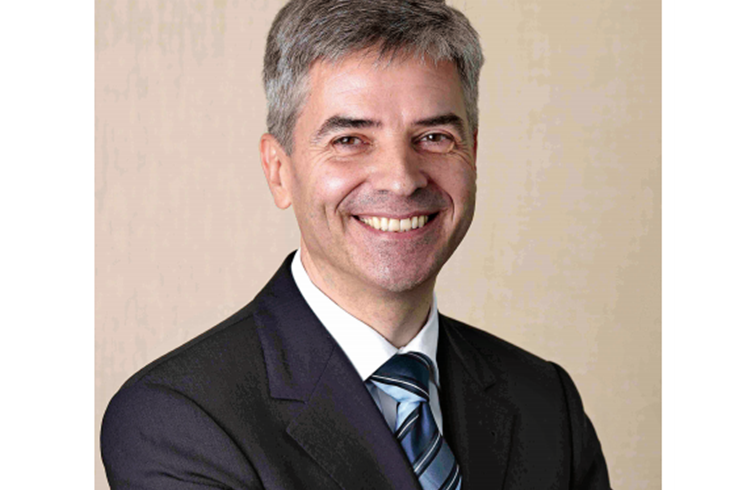'We reach any customer in India within four hours. This is a benchmark in the industry.'
In terms of technology, better electronics for active braking systems’ needs to monitor trucks will be a huge boost.
Daimler India Commercial Vehicles' CEO and MD speaks to Kiran Bajad on its growth strategy, introducing more products in the 14T and 10T segments, a sub-9T platform for export models, and why he does not see any immediate need to expand the dealer network.
Five years and 55,000 trucks sold in India. How do you view this journey and what was the most difficult part?
We have promised to modernise the truck market in India and in the past five years have certainly achieved a lot. We will surely achieve even more as the technologies are coming in and enabling us to accelerate even more. There is going to be more and more modernisation coming in Indian trucks in the future.
The difficulty was what we had wrongly assessed the new regulations that will be come in India. A lot was promised many years ago in the form of GST and a Truck Code but we could not anticipate the delays. Competition can always be taken into consideration but we couldn’t foresee the regulatory delays.
Our countermeasure was the focus on other markets with exports. Today, we export to our trucks to the southern hemisphere under the BharatBenz, Fuso and Mercedes-Benz brands. All this is possible only because we have the highest quality. We have made the same quality promise to the Indian customer and giving the same export quality truck. We don’t produce different trucks for the domestic and export markets – they are similar in quality.

How do you see the next few years for the Indian CV industry and for DICV?
I see the Indian trucking industry as getting modern, and with GST in place fleets will become more organised. Customers are looking at modern fleet management solutions and we already offer our Daimler Connect modern fleet management solutions. There is higher activity in high-tonnage trucks like 49T tractors as overloading is getting regulated. In India, there is a shortage of qualified drivers but for the existing road infrastructure, a tractor-trailer is 10 times better than a five-axled truck.

I would say our next 55,000 trucks will certainly won’t take five years and we will further accelerate our growth in 2018. We are ramping up every quarter for both our domestic and export businesses. Currently, our export and domestic operations are nearly equal. If demand grows for domestic products, we may trim down our exports to focus on the local demand.
You have 14 different models in the 9-49T market in India? Where do you see the gaps and what is the roadmap for product portfolio expansion?
We have 14 models in the domestic market but also more models in the export market both in left- and right-hand drive markets. In early 2018 we will get an additional sub-9T platform, which is only for the export market. In the domestic market, we are sufficiently placed and there will be some moment in between to introduce more products in different tonnage segments like the 14T and 10T. Our trucks are modular and we can respond to the changing market dynamics.
The sub-9T is completely a new family and there would be many variants. Now we have MDT, HDT and HHDT; the new sub-9T means we will have four different families and there is a lot of scope to play within these families. I don’t see any immediate need to introduce any fifth product family.
Truck buyers always consider the network and aftersales service before making a purchase decision. How does DICV stand on this front at present?
We have 130 touch points across the country in different sizes of dealerships including 5S and 3S. We also have our service vans. We reach any customer in India within four hours; this is a benchmark in the industry and this is what we monitor regularly. Is it necessary to add more dealerships? Maybe not? It is important how fast we reach the customer or they come to us. You also need to consider that Bharat Benz trucks’ reliability is better and they don’t break down often. Further, we are adding more connectivity into our trucks with all the data with us which we will use send alerts to customers for any service-related issue.
Therefore, increasing service stations is not really required with new technology. We will have a limited numbers of dealers and outlets to maximise what is required but ensure better service to customers.
How do DICV sales fare across different regions of the country?
We are doing extremely well in north and south India. We see further potential in the west; it is not that we are unsatisfied with the market but the size of the market is growing and we will see more growth. The east is doing better than we expected but in terms of vehicle portfolio, north India is more modern.
BS IV in place and BS VI just three years away, how do you see the Indian CV industry progressing technology-wise?
The next step is staying in connectivity and there will be faster upgradation in this area than anybody expects. A good number of Indian customers are extremely tech-savvy and would further need live driver monitoring to reduce causalities. We are ready with this because safety is the call of the hour and it’s our mission. This is our focus area and it's good for our fleet customers with less accidents, downtime and repair cost.
The investment in a modern truck has to do with economics, environment and human being but it also has to do something with economics. In terms of technology, better electronics for active braking systems’ needs to monitor trucks will be a huge boost.
Why did DICV launch a Euro 5 truck in India when the market is moving to BS VI?
We feel absolutely responsible to do something and don’t want to wait until BS VI comes into effect (in 2020). BS VI is more difficult to manage but if we do now something for the environment, it is much more important than waiting for three years. So why should we wait for having better solutions? That is why we want to promote this kind of truck to talk to responsible citizens. We believe, how we produce a truck needs to be environment-friendly, it has to be the most fuel efficient.

How easy is it for the CV industry to move to BS VI by 2020? Was leapfrogging BS V the right move?
We could have jumped directly to Euro 5 (BS V) which is about available technologies. We said we can do Euro 4 and Euro 5 that is why we showcased the truck. But this is not only to showcase but to over-fulfill regulation. I cannot comment on my competitors but we are ready to do this.
Given that Indian cities are getting extremely polluted, we need immediate attention to do something right now. If I were the government, then I would promote Euro 5 trucks in cities and scrap all trucks which are below Euro 3 immediately; this would lead to much better air straightaway. I think the industry in India is not prepared for Euro VI (BS VI)and you need much better fuel and a well-developed infrastructure.
Where do you see the growth coming for DICV? How is the market demand shaping up?
The tractor business is certainly growing rapidly, the 37T segment sees huge demand but India has to move more and more into the tractor-trailer business which is more viable and economical. I believe the construction business will grow exponentially as India is investing heavily in infrastructure. I also don’t see the MDT market shrinking simply because of the hub-and-spoke model with more deliveries inside the cities.
You have an ambitious goal of 20 percent market share in the HDT segment by 2020. How confident are you with this aggressive target? What would be the major pillar of this goal?
We are certainly aiming for this and are not going to stop. Everything will depend on the market conditions and we will continue to focus on what is important for the domestic or export markets. While we don’t have any pressure to achieve 20 percent market share by or before any deadline, we will maximise everything possible but always in an economical manner. This means if the export market is strong, we will also support it. But certainly, despite intense competition in India, our trucks have been well accepted and we are firmly established. The customer sees value in our trucks and, therefore, we are not in any kind of discount game to fight for market share.
DICV has also expanded into buses. How do you see that business shaping up?
We have been making trucks since five years now. We started selling buses just two years ago. This is the same phase we had for the trucks. This is where the ramp-up production happens and we have a full-fledged bus portfolio with introduction of staff, school and tourist segments. Till date, we have received a good response and we have to do the same thing what we have done in the truck business like establishing ourselves more and more to reach wider customers. There will be some action in the bus business in the near term. We also export a lot of bus chassis from India to Indonesia, Latin America and the Middle East in large numbers.
(This interview was first published in the October 15, 2017 print edition of Autocar Professional)
RELATED ARTICLES
BRANDED CONTENT: 'We aspire to be among the leading sensors and electro-mechanical products manufacturer'
P. Parthasarathy, Founder & Managing Director, Rotary Electronics Pvt Ltd shares the company's commitment and vision to ...
‘Big opportunity for startups lies in products in India’: Detlev Reicheneder
As electrification levels the playing field, the focus on tech and R&D to bring innovative products is the mantra for st...
'I hope my journey makes people say — I can do this too'
Ranjita Ravi, Co-founder of Orxa Energies — the maker of Mantis e-bikes — shares the challenges of building a startup an...





 01 Nov 2017
01 Nov 2017
 5211 Views
5211 Views





 Autocar Pro News Desk
Autocar Pro News Desk




